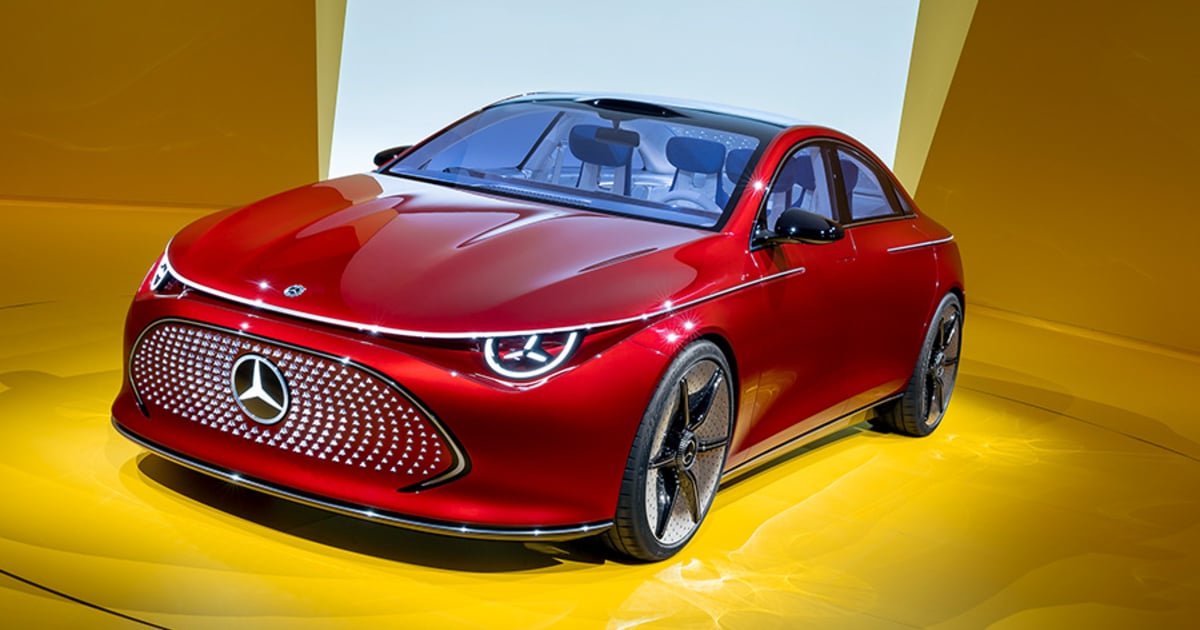
MUNICH — The IAA Mobility show here that kicked off on Monday showcased a range of important new cars, giving fans of auto shows hope that the format might revive in Europe.
Audi, BMW, Mercedes-Benz, Mini, Renault, Seat, Volkswagen — as well as the Chinese newcomer Avatr — were among those unveiling new cars, while Chinese automakers BYD, Dongfeng Forthing, Leapmotor, Seres and Xpeng used the event to make announcements about their European expansion.
These were the five cars that caught our eye in Munich.
Mercedes built the Concept CLA Class its own two-story, windowless showroom in the heart of Munich, where the vibe was more fashion show than auto show. A light display from the car itself showed off extensive use of LEDs on the grille, roof and within the cabin, which has “spa-like elegance,” according to the automaker.
Unlike other concepts at the event, the CLA Class made heavy use of chrome. The car previewed an electric compact sedan on the new MMA (Mercedes-Benz Modular Architecture) platform that introduces 800-volt technology for the first time within the brand for faster charging as well as more efficient energy use. Mercedes claimed electric consumption of 8.4 km (5.2 miles) per kilowatt hour, an equivalent it said of the so-called 1-liter car, referring to superfrugal combustion engines.
Countering the Chinese newcomers at IAA, VW sought to prove with the ID GTI hot hatchback concept that there is no substitute for brand depth when it comes to bringing customers along on the EV journey.
The GTI previewed a sporty version of VW’s full-electric small car due in 2025 — potentially called the ID2 — but made sure there was plenty of design links to VW’s extensive back catalogue of GTI models, starting with the first-generation Golf from 1976. The references included an d version of the original’s tartan-pattern seats as well as the red-rimmed grille.
The design, presented on Sunday night by new VW styling boss Andreas Mindt, was safe rather than challenging but is probably the right step to persuade more conservative buyers to give up their combustion engine cars. The GTI model also will be key to Volkswagen making decent margins on its electric small cars, which are promised to start at 25,000 euros.
BMW built more than one example of its Vision Neue Klasse concept to be able to show off its future both at the Munich fairgrounds and at its more public-facing stand elaborately constructed in downtown Munich.
Plaudits abounded for the car, which previews a new midsize sedan on the Neue Klasse electric platform due in 2025. The slim pillars and large greenhouse recalled BMW sedans of the 1960s and 1970s while the reimagined kidney grille slimmed down a feature that some feared was only going to get larger.
“At last … some taste back in BMW Design,” Ian Callum, previously the head of design for BMW rival Jaguar wrote on X (formerly Twitter). The matte surfaces and textile-heavy interior showcased a new luxury aesthetic that puts clear distance between BMW and premium rival Mercedes.
BYD bills itself as the world’s largest new energy vehicle (NEV) maker (including plug-in hybrids) and was a big supporter of the Munich show, with a large stand in the main conference center and multiple satellite locations in the city.
The newest car to debut was the Seal U midsize SUV, which joins the Seal sedan in the first half of 2024, but in a body style more suited to European tastes. The car shares the same basic styling features but looked a little less techy, a little more rugged and a touch more anonymous.
The price of the Seal U is expected to climb from the 42,990 euros BYD charges for the base sedan in Germany, but the driving range is competitive with a claimed 420 km (261 miles) for the base Comfort with a 72-kilowatt-hour battery, rising to 500 km for the Design with its 87-kWh pack. DC charge is up to 140 kilowatts, with a heat pump as standard.
Avatr, a Chinese premium electric vehicle startup, chose Munich to launch the second car in its “smart EV” range, a large sedan named 12 (pronounced “one two”). The slippery-looking 5000 mm long sedan has no rear window, extending the rear trunk lid and giving it a more fastback shape.
CEO Tan Benhong was on hand to show off the car at the company stand at one of IAA’s urban locations in the Koenigsplatz square. There he posed with employees from the company’s Munich-based design studio — and told Automotive News Europe the company is targeting European sales within two years.
Avatr is a formidable joint venture between state-owned carmaker Changan, global battery leader CATL and tech giant Huawei. The car is expected to use CATL’s recently announced Shenxing Superfast Charging Battery, which can add 400 km of range in just 10 minutes of charging. Avatr has already said it will be one of the first to use the battery.